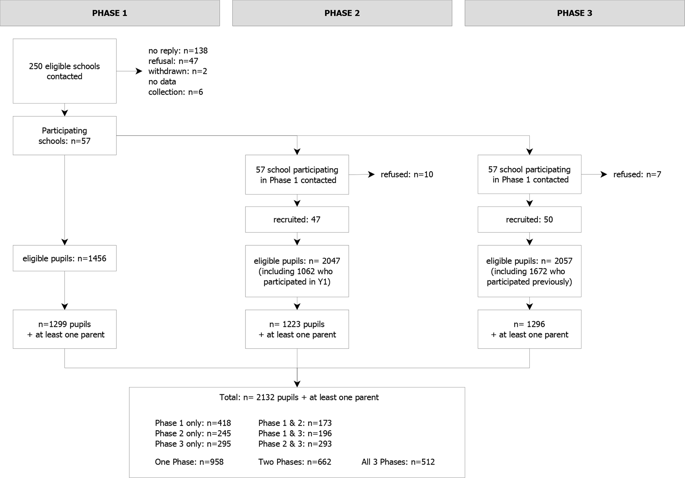当前位置:
X-MOL 学术
›
Int. J. Obesity
›
论文详情
Our official English website, www.x-mol.net, welcomes your
feedback! (Note: you will need to create a separate account there.)
Association of BMI category with change in children's physical activity between ages 6 and 11 years: a longitudinal study.
International Journal of Obesity ( IF 4.2 ) Pub Date : 2019-11-12 , DOI: 10.1038/s41366-019-0459-0 Russell Jago 1 , Ruth Salway 1 , Lydia Emm-Collison 1 , Simon J Sebire 1 , Janice L Thompson 2 , Deborah A Lawlor 3, 4
International Journal of Obesity ( IF 4.2 ) Pub Date : 2019-11-12 , DOI: 10.1038/s41366-019-0459-0 Russell Jago 1 , Ruth Salway 1 , Lydia Emm-Collison 1 , Simon J Sebire 1 , Janice L Thompson 2 , Deborah A Lawlor 3, 4
Affiliation

|
BACKGROUND/OBJECTIVES
To examine the association of body mass index (BMI) with change in children's physical activity and sedentary time between ages 6 and 11.
PARTICIPANTS
A total of 2132 children participated from 57 schools in Southwest England, from the B-PROACT1V study.
METHODS
Mean minutes of MVPA and sedentary time per day were derived from accelerometer-based measurements at ages 6, 9 and 11. Linear multilevel models examined the association of BMI categories with MVPA and sedentary time between 6 and 11, adjusting for seasonality, wear time, gender and household education. Differences in change over time were examined using interaction terms.
RESULTS
Average weekday MVPA decreased between ages 6 and 11 by 2.2 min/day/year (95% CI: 1.9 to 2.5), with a steeper decline at weekends. Average sedentary time increased at a rate of 12.9 min/day/year (95% CI: 12.2 to 13.6). There were no differences in mean levels of MVPA by BMI categories at age 6, but differences emerged as children aged, with the gap between children who were healthy weight and overweight increasing by 1.7 min/day (95% CI: 0.8-2.6) every year, and between healthy and obese by 2.0 min/day (95% CI: 0.9-3.1) each year. Children who were overweight/obese engaged in less average weekday sedentary time at age 6 than those of healthy weight, but the gap closed by age 11.
CONCLUSION
MVPA declines and sedentary time increases on average for all children between ages 6 and 11. While there are no differences in activity levels by BMI category at age 6, differences in MVPA emerge over time for those who are overweight and obese. Developing interventions that support children to retain activity levels as they approach older childhood, particularly those who are overweight/obese could improve public health.
中文翻译:

BMI 类别与 6 至 11 岁儿童体力活动变化的关联:一项纵向研究。
背景/目的 研究体重指数 (BMI) 与 6 至 11 岁儿童体力活动和久坐时间的变化之间的关系。参与者 来自英格兰西南部 57 所学校的总共 2132 名儿童参加了 B-PROACT1V 研究。方法 MVPA 的平均分钟数和每天的久坐时间来自 6、9 和 11 岁时基于加速度计的测量值。线性多级模型检查了 BMI 类别与 MVPA 和 6 至 11 岁之间的久坐时间之间的关联,调整了季节性、磨损时间、性别和家庭教育。使用交互项检查随时间变化的差异。结果 6 至 11 岁的平均工作日 MVPA 下降 2.2 分钟/天/年(95% CI:1.9 至 2.5),周末下降幅度更大。平均久坐时间增加了 12 分钟。9 分钟/天/年(95% CI:12.2 至 13.6)。6 岁时不同 BMI 类别的 MVPA 平均水平没有差异,但随着儿童年龄的增长出现差异,健康体重和超重儿童之间的差距每增加 1.7 分钟/天(95% CI:0.8-2.6)。年,健康和肥胖之间每年相差 2.0 分钟/天(95% CI:0.9-3.1)。超重/肥胖的儿童在 6 岁时的平均工作日久坐时间少于健康体重的儿童,但到 11 岁时差距缩小。结论 6 至 11 岁之间所有儿童的 MVPA 平均下降和久坐时间增加。虽然有6 岁时 BMI 类别的活动水平没有差异,但对于超重和肥胖的人,MVPA 的差异会随着时间的推移而出现。
更新日期:2019-11-13
中文翻译:

BMI 类别与 6 至 11 岁儿童体力活动变化的关联:一项纵向研究。
背景/目的 研究体重指数 (BMI) 与 6 至 11 岁儿童体力活动和久坐时间的变化之间的关系。参与者 来自英格兰西南部 57 所学校的总共 2132 名儿童参加了 B-PROACT1V 研究。方法 MVPA 的平均分钟数和每天的久坐时间来自 6、9 和 11 岁时基于加速度计的测量值。线性多级模型检查了 BMI 类别与 MVPA 和 6 至 11 岁之间的久坐时间之间的关联,调整了季节性、磨损时间、性别和家庭教育。使用交互项检查随时间变化的差异。结果 6 至 11 岁的平均工作日 MVPA 下降 2.2 分钟/天/年(95% CI:1.9 至 2.5),周末下降幅度更大。平均久坐时间增加了 12 分钟。9 分钟/天/年(95% CI:12.2 至 13.6)。6 岁时不同 BMI 类别的 MVPA 平均水平没有差异,但随着儿童年龄的增长出现差异,健康体重和超重儿童之间的差距每增加 1.7 分钟/天(95% CI:0.8-2.6)。年,健康和肥胖之间每年相差 2.0 分钟/天(95% CI:0.9-3.1)。超重/肥胖的儿童在 6 岁时的平均工作日久坐时间少于健康体重的儿童,但到 11 岁时差距缩小。结论 6 至 11 岁之间所有儿童的 MVPA 平均下降和久坐时间增加。虽然有6 岁时 BMI 类别的活动水平没有差异,但对于超重和肥胖的人,MVPA 的差异会随着时间的推移而出现。











































 京公网安备 11010802027423号
京公网安备 11010802027423号